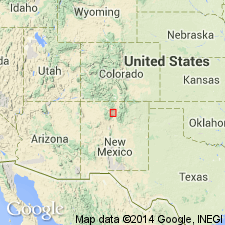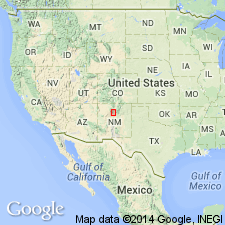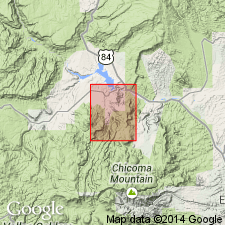
- Usage in publication:
-
- Lobato basaltic lavas
- Modifications:
-
- First used
- Dominant lithology:
-
- Lava
- AAPG geologic province:
-
- San Juan basin
Summary:
First used. Listed only. No type locality designated. Is in Abiquiu quad, Rio Arriba Co, NM, in San Juan basin. Younger than Canones andesite (new) and older than Puye gravel (new). Is of Quaternary age.
Source: GNU records (USGS DDS-6; Denver GNULEX).

- Usage in publication:
-
- Lobato Basalt*
- Modifications:
-
- Named
- Geochronologic dating
- Dominant lithology:
-
- Lava
- AAPG geologic province:
-
- San Juan basin
Summary:
Named as lowest member of Polvadera Group (new) for Lobato Mesa, which is designated the type area, T22N, R6E, Abiquiu quad, Rio Arriba Co, NM in San Juan basin where formation is thickest. Name proposed for basaltic lavas that form the high-level mesas fringing north and northeast sides of Jemez Mountains. Well exposed on eastern escarpment of the mesa. Maximum thickness of 600 ft on Lobato Mesa and consists of many flows ranging from 20-50 ft in thickness. Flows predominantly olivine-augite basalts, but hypersthene-, pigeonite-, and titaniferous augite-bearing varieties also occur. Rests on erosion surface locally veneered by boulders and cobbles of Precambrian crystalline and metamorphic rocks; underlain by Abiquiu Tuff and arkosic sands of Santa Fe Formation. Overlain for most part by dacites and quartz latites of Tschicoma Formation (new); locally interbedded with an early dacite flow of Tschicoma. Is middle Pliocene in age. Radiometric age of 7.4 m.y. obtained on one flow from Polvadera Mesa (written communication to author, Dalrymple, 1967). Postdates Abiquiu Tuff of Miocene? age and arkosic sands of Santa Fe of probable late Miocene and early Pliocene age. Mostly predates Tschicoma Formation, which has been dated radiometrically as middle and late Pliocene.
Source: GNU records (USGS DDS-6; Denver GNULEX).

- Usage in publication:
-
- Lobato Basalt*
- Modifications:
-
- Age modified
- Geochronologic dating
- AAPG geologic province:
-
- San Juan basin
Summary:
Age of Lobato Basalt, basal formation of Polvadera Group changed from middle Pliocene to Pliocene and late Miocene based on radiometric dates of 7.8, 7.6, 3.1, and 2.8 m.y. Report area is Canones quad, Rio Arriba Co, NM in the San Juan basin.
Source: GNU records (USGS DDS-6; Denver GNULEX).
For more information, please contact Nancy Stamm, Geologic Names Committee Secretary.
Asterisk (*) indicates published by U.S. Geological Survey authors.
"No current usage" (†) implies that a name has been abandoned or has fallen into disuse. Former usage and, if known, replacement name given in parentheses ( ).
Slash (/) indicates name conflicts with nomenclatural guidelines (CSN, 1933; ACSN, 1961, 1970; NACSN, 1983, 2005, 2021). May be explained within brackets ([ ]).

